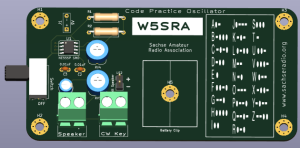Difference between revisions of "CW Practice Oscillator Kit"
| Line 4: | Line 4: | ||
I decided to make a CW practice board for Morse Code training for my local HAM club. I have donated all 10 boards to the club. | I decided to make a CW practice board for Morse Code training for my local HAM club. I have donated all 10 boards to the club. | ||
| − | It was a simple process to use KiCad 7.0 to design the board. | + | It was a simple process to use KiCad 7.0 to design the board. |
| − | I am not going to explain how to use KiCad in this wiki page since I have other wiki pages explaining how to use KiCad. | + | I am not going to explain how to use KiCad in this wiki page since I have other wiki pages explaining how to use KiCad.<br> |
| − | This project uses a NE555 timer SMD SOIC-8 Chip that produces a square wave that can be adjusted between 300Hz and 1KHz | + | This project uses a NE555 timer SMD SOIC-8 Chip that produces a square wave that can be adjusted between 300Hz and 1KHz |
| − | + | The power source is a 9Volt battery that is connected to J2 via a 9V BATTERY STRAP from Mouser Electronics. | |
| − | + | This Kit was designed to be adjustable for the user to change to the tone to their preferred listening levels. | |
| + | RV4 is a 200K ohm variable resistor that controls the tone between 300Hz to 1KHz. | ||
RV3 is a 100 Ohm variable resistor that controls the volume. | RV3 is a 100 Ohm variable resistor that controls the volume. | ||
| − | + | The CW key is connected to a 5mm Terminal block that is label CW Key | |
| − | The CW key is connected to a Terminal block that is label CW Key | + | This Kit comes with a 55mm Speaker that is connected J3 and placed underneath the bottom of the PCB. |
| + | There is another speaker connector that uses a 5mm Terminal block with the label Speaker for larger speakers. | ||
Revision as of 03:43, 23 February 2024
I decided to make a CW practice board for Morse Code training for my local HAM club. I have donated all 10 boards to the club. It was a simple process to use KiCad 7.0 to design the board. I am not going to explain how to use KiCad in this wiki page since I have other wiki pages explaining how to use KiCad.
This project uses a NE555 timer SMD SOIC-8 Chip that produces a square wave that can be adjusted between 300Hz and 1KHz The power source is a 9Volt battery that is connected to J2 via a 9V BATTERY STRAP from Mouser Electronics. This Kit was designed to be adjustable for the user to change to the tone to their preferred listening levels. RV4 is a 200K ohm variable resistor that controls the tone between 300Hz to 1KHz. RV3 is a 100 Ohm variable resistor that controls the volume. The CW key is connected to a 5mm Terminal block that is label CW Key This Kit comes with a 55mm Speaker that is connected J3 and placed underneath the bottom of the PCB. There is another speaker connector that uses a 5mm Terminal block with the label Speaker for larger speakers.
